Sam Browne Trade Patterns, subdued: Thresher Leather-Drill Sam Browne
Equipment Carriers
Come on, readers! We were hoping some of you might be able to offer photographs of the more mundane component of this pattern – the belt, braces, frog and ammunition pouch. Instead, our first addition is at the exotic end of the scale.
Case, pistol, Webley Mk. VI

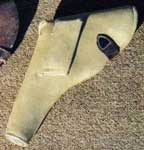 This example of Pistol case shows a simplified belt loop and not the form that Sam Browne would have required, which corresponds to other examples noted. Here, the Case is – by Sam’s requirement – incorrectly aligned to push the pistol muzzle forwards, when worn on the right-hand side. If the Thresher form of Sam Browne Belt is completely fitted-up with brass loops, etc, it would be inconvenient to thread the Case over to the left side of the belt. No example of opening belt loop is known. This example is from the John Bodsworth Collection, photographs © John Bodsworth 2010.
This example of Pistol case shows a simplified belt loop and not the form that Sam Browne would have required, which corresponds to other examples noted. Here, the Case is – by Sam’s requirement – incorrectly aligned to push the pistol muzzle forwards, when worn on the right-hand side. If the Thresher form of Sam Browne Belt is completely fitted-up with brass loops, etc, it would be inconvenient to thread the Case over to the left side of the belt. No example of opening belt loop is known. This example is from the John Bodsworth Collection, photographs © John Bodsworth 2010.
Case, pistol, automatic, Type 1
Carrier, magazines, pistol, automatic, Type 1
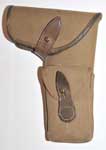
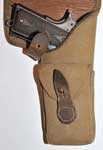
 Since this is cotton drill bonded to an otherwise leather Holster, it has been included under the Thresher section. The “squared-off” form of the Holster gives away its purpose – a Holster for an automatic, here a .Colt M1911. This was available to officers in the regulation .455 calibre, the model shown here. Prior to the Great War, automatic pistols were not common amongst Army officers.
Since this is cotton drill bonded to an otherwise leather Holster, it has been included under the Thresher section. The “squared-off” form of the Holster gives away its purpose – a Holster for an automatic, here a .Colt M1911. This was available to officers in the regulation .455 calibre, the model shown here. Prior to the Great War, automatic pistols were not common amongst Army officers.
The distinctive “squared” form, has additional shaping to accommodate the trigger guard, masked here by a user-modification. The two-cell Magazine pocket, for a pair of 7-round magazines, was originally designed for separate belt carriage. Its two leather loops have been removed and re-stitched at 90 degrees to their original alignment. This allowed the Pocket to be slipped onto the barrel section of the Holster, where it has been stitched into place. The diagonal orientation of the belt loop suggests it was worn on the left, for a cross-hand draw.
Around 1917, .455 Colts were issued to the Royal Flying Corps, who continued to use them after they became the Royal Air Force, on 1st April 1918. Holster and Colt from the Paul Hannon Collection. Photographs © Paul Hannon, 2010.
Case, pistol, automatic, Type 2
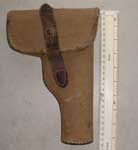

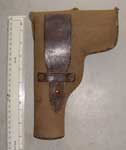 This example, from the Ron Jacob’s Collection, is also for a .455-in. Colt M1911 Automatic, but follows the more usual contoured form of the leather Holsters that are known. With no provision for magazines, it follows there must have been some form of cotton-drill covered Magazine carrier. This would probably for two magazines, but leather 4-pocket Magazine carriers for the .455-in. Webley Auto have been noted being worn on Sam Browne Belts.
This example, from the Ron Jacob’s Collection, is also for a .455-in. Colt M1911 Automatic, but follows the more usual contoured form of the leather Holsters that are known. With no provision for magazines, it follows there must have been some form of cotton-drill covered Magazine carrier. This would probably for two magazines, but leather 4-pocket Magazine carriers for the .455-in. Webley Auto have been noted being worn on Sam Browne Belts.
The S.B. Belt’s dees made it difficult to slide a properly sized Holster round from the running end of the belt. The opening belt loop is fastened, under a flat loop, to a pillar stud and is typical of similar Sam Browne Holsters and was fitted for ease of attachment to the left side of the belt, for a cross-hand draw. Obviously it could be for a left-handed user, who preferred a draw in U.S. Cavalry style, their “hog-leg” holsters being worn on the right, butt forwards.

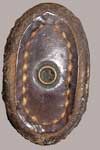 The muzzle opening is closed with an un-covered leather insert, with a drain hole, box-stitched into place. The holster seam is butt-stitched, in the usual Sam Browne manner. Photographs © Ron Jacobs, 2010.
The muzzle opening is closed with an un-covered leather insert, with a drain hole, box-stitched into place. The holster seam is butt-stitched, in the usual Sam Browne manner. Photographs © Ron Jacobs, 2010.
NOTE ON .455-in. AMMUNITION
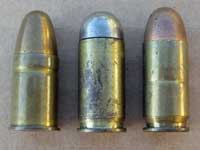
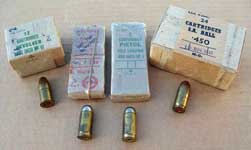 Despite a requirement to use pistols taking issue ammunition, any officer purchasing a .455-in. Colt M1911 had already made a decision to use a round that was less widely available within the Army, so would probably be responsible for his own ammunition supply. The .455 Webley revolver round (far left) was rimmed, whereas the .455 auto round (centre left) was semi-rimmed. At near left is a .45 ACP (Automatic Colt Pistol) round which was a rimless cartridge. Between 1912 and July 1915, 4,200 Colts were imported into the U.K. and were calibre .45 ACP. From 1915 to 1919, 13,300 .455 Colt Autos were imported, of which 600 were for commercial sale and 2,200 for the War Office, the balance going to the R.F.C.. The semi-rimmed round was used by the Royal Navy, who had adopted the Webley Automatic pistol as a limited standard. One hundred Webley Autos were also issued to the Royal Horse Artillery and Royal Flying Corps. The latter Corps had also received 10,200 Colt .455-in. Automatic, starting around 1917, which used the same Webley Auto round. Having effectively ignored the requirement to use the more common revolver round, there was no reason why his choice of pistol might be other than a Colt, in calibres other than .455-in. too. Cartridges from the Terry Hawker Collection. Photograph © Terry Hawker, 2010.
Despite a requirement to use pistols taking issue ammunition, any officer purchasing a .455-in. Colt M1911 had already made a decision to use a round that was less widely available within the Army, so would probably be responsible for his own ammunition supply. The .455 Webley revolver round (far left) was rimmed, whereas the .455 auto round (centre left) was semi-rimmed. At near left is a .45 ACP (Automatic Colt Pistol) round which was a rimless cartridge. Between 1912 and July 1915, 4,200 Colts were imported into the U.K. and were calibre .45 ACP. From 1915 to 1919, 13,300 .455 Colt Autos were imported, of which 600 were for commercial sale and 2,200 for the War Office, the balance going to the R.F.C.. The semi-rimmed round was used by the Royal Navy, who had adopted the Webley Automatic pistol as a limited standard. One hundred Webley Autos were also issued to the Royal Horse Artillery and Royal Flying Corps. The latter Corps had also received 10,200 Colt .455-in. Automatic, starting around 1917, which used the same Webley Auto round. Having effectively ignored the requirement to use the more common revolver round, there was no reason why his choice of pistol might be other than a Colt, in calibres other than .455-in. too. Cartridges from the Terry Hawker Collection. Photograph © Terry Hawker, 2010.
© R.J. Dennis February 2009